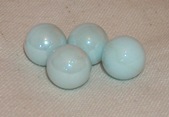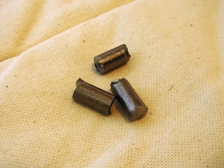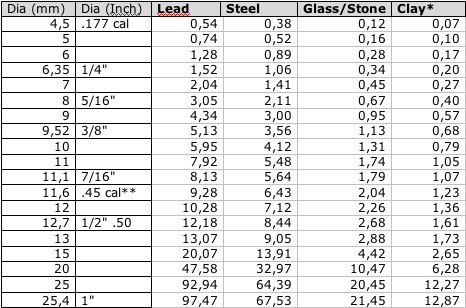













Many projectiles can be used with a slingshot. I will try to list the most common types.

Marbles are probably the most common ammo for past time shooting as they are so cheap and available in every supermarket. The biggest advantage of them is their high visibility, they can be tracked during flight, so the shooter can easily adjust his aim until he hits the target. They are also easier spot and recollect than steel bearings. The even, round shape makes marbles perfectly accurate , but the low density of glass compared to steel or lead means that you better take other ammunition for hunting, long-range shots or other occasions when high power is needed. Typical marbles (or glass shot) have a diameter of 1/2" or higher, therefore, most people find them easier to hold than steel or lead shot with smaller caliber. Because of price and the before mentioned advantages, I recommend you to use marbles instead of 1/4" steel ammo.The glass ammo from slingshot manufacturers is usually more expensive, but it has a bright color that makes it even easier to see in flight, and a guaranteed consistent size.

Steel shot is the most common type of ammo. It comes in different sizes, usually 1/4", 5/16", 3/8" and 1/2".It is used for target shooting as well as for hunting. Steel ammunition does also have the advantage of being almost impossible to destroy, so it can be used over and over again if you have a backstop.Larger sizes such as 1/2" are heavy enough for hunting, and the ammo of choice for most professional shooters. The even, round shape makes steel bearings the standard ammo on most slingshot tournaments. A strong magnet makes steel balls also simple to recollect and handle. A disadvantage is their ability to ricochet, never shoot them against a hard surface!

Lead has the highest density of all common materials, so a lead ball gets interesting if you need some heavy ammunition. Not surprisingly, lead balls are most popular among hunters who need every bit of power to down their quarry humanely. The relatively high price can be lowered to almost zero if a mold is used to cast ammo by yourself. Disadvantages of the lead ammo are the environmental and health problems that come along with lead, and the soft balls deform quickly when they strike a hard surface. Therefore, I recommend lead balls to hunters only, and to people who want to create extraordinary powerful slingshots. As lead is so dense, there's usually no need for calibers over .50, a cal .44 ball is considered as a very good hunting ammo.

Ask a layman about slingshot ammo and 90% will answer "rocks". And indeed, small stones are used all over the world because they don't cost anything. Most shooters are disappointed when they try to shoot with them. The reason is they pick stones the size of their steel balls (not more than 1/2" in diameter). If you want to shoot such stones, be very careful and picky. Only take pebbbles with a uniform, round shape. The key to successful stone shooting is to use large rocks, with about 1" diameter and a weigth of 14-20 grams. The large mass compensates the stone's imperfect shape to some degree, as its high momentum forces the stone in a straight line for a sufficiently long distance. To use projectiles of this size, your slingshot's pouch size must be larger than what's needed for steel balls. A pouch with 4"x1.5" (10cm x 3,7cm) would be a good choice for stones. Your slingshot also needs sufficient space between the fork ends to let the stone pass by without danger.

Clay balls are the most underrated type of ammunition. They are almost free, leave no shards, don't ricochet and are totally biodegradable. Just shoot them wherever you want and the next rain washes the remains away. However, the denisty of clay is even lower than that of glass. This limits the accuracy to short ranges, maybe up to 10 meters. Just as with stones, you can increase the usable range by increasing the ammunition's size. Large clay balls (1" and more) have the necessary weight to be used for serious shooting. They also need a slingshot that is adapted to shoot such large projectiles by having a larger pouch and a wide fork opening.
When you want to make your clay ammo, just get the cheapest pug of pottery/sclupting clay. There is neither need for firing the balls in an oven - just let them dry in the sun - nor do you require special air-drying clay.

Paintballs are fun ammunition for accurate close-range target shooting. They make visible splats on any hard surface, don't ricochet and pose no big danger to bystanders. Disadvantage is that, obviously, they are not reusable and can be crushed in the pouch if you don't take care. In case you want to play paintball with slingshots, be aware that many slingshots have more power than paintball markers! Clay balls also leave a visible spot on a hard surface and won't break to mess up your pouch, think about using those if you just need see where you hit on a target.

Cylindrical ammunition is not as accurate when you shoot them beyond 10-15 meters,but accuracy is very good on short ranges. It is easy to hold and faster to reload. The best part about it is that it can be made for almost free, just get 8mm nails or iron rods and chop or saw off pieces of about one centimetre in length. You usually find sharp edges on this selfmade ammo which can kill your backstop or cut your hands. Disadvantage is the high amount of work that has to be done to get a fair number of these pellets. Using a saw is too much work (unless you really have no other ammunition source), but if you have a good bolt cutter, you can make this type of ammunition fast enough.

Hex nuts can be quite cheap when purchased in bulk. They are surprisingly accurate and powerful. While inferior to steel balls, they are very useful for those who don't have access to steel balls or want to keep the ammo cost low without sacrificing too much power. The non-aerodynamical shape is no problem for close distances, but takes its toll on longer ranges. You must take great care to center a hex nut precisely in the center of your pouch to maintain accuracy.
The wheels of cars have small lead weights that can be obtained for free from garages and car dumps. You can chop these in pieces with pliers and use them as heavy ammo. The high density compensates the uneven shape, even for medium-range shots. This ammo was once the favorite for US hunters with a small budget. Disadvantages are the environmental and health issues that come along with lead, the soft material will flatten easily and the edges may cut your backstop, pouch and hands.
Some manufacturers sell plastic balls for their slingshots. They are far too lightweight, relatively expensive and not biodegradable. Plus, they ricochet when they hit a hard surface. There is, in my opinion, no point in using them.

*Weigth varies, depending on type of clay and moisture content
** 11.6mm (.457") is the actual size of a ".45 cal" muzzleloader lead ball
Have a look at the Weight table and you can see dramatic differences between, say, an 1/4" steel ball and a .44 lead ball. With common "heavy pull" bands like the Trumark RR-2, the Barnett or Saunders heavy pull bands, a 1/2" steel shot carries more than 4 times the power than a 1/4" steel pellet, and almost double the power of a 3/8" projectile. I always urge shooters not to give too much attention to "power" and rather focus on accuracy and shooting pleasure, but it's pretty clear that a hunter or long-range shooter won't be happy with a 1/4" steelie or a small marble. The long-range guy won't be happy with a huge lead ball either as it gives him a bad trajectory bow, he might use something like a 10mm steel bearing.
There's two thing to be said about this: The higher the projectile's density, the less will it be affected by its shape. A lump of lead will always fly straight, an irregular stone will not. Second, it takes a while for an irregular projectile to align in the airflow and change its path. The accuracy of irregular ammunition is usually quite good on the first few meters, and then opens up dramatically. This means you can use non-spherical projectiles on short ranges with goo success, but forget about them for longer shots!
A target shooter prefers perfectly spherical ammunition such as glass marbles, steel or carefully rolled rolled clay ammo. He tends to use the largest diameter that's allowed in the tounament, this will slightly improve the odds between near-hit and just nicking the target. He'll usually use a backstop, so ammo price is plays no big role for him.
A casual shooter can shoot the same ammunition as the target shooter when he uses a backstop. Clay ammunition is perfect for outdoor use, but other inexpensive ammunition such a hex nuts, small-diameter steel balls, mables etc. asre freqeuently used, too.
The most common kinds of hunting ammunition are lead balls in the range of .38"-.45" and 7/16"-1/2" steel balls. A hunter will consider the use of hex nuts or large cylindrical ammo (8-12 g in weihgt) for short range brush hunting (8 yards or less) because the irregular shape deals some more damage to the quarry.
It's beneficial to use pairs of ammuntion of different material that are roughly similar in size and weight. For example, a shooter can use marbles when he is at home and uses his backstop to save the ammo, and clay balls of the same size and weight when he is shooting outside. A hunter can train with 1/2" steel balls and use 7/16" lead shot of similar weight for hunting.